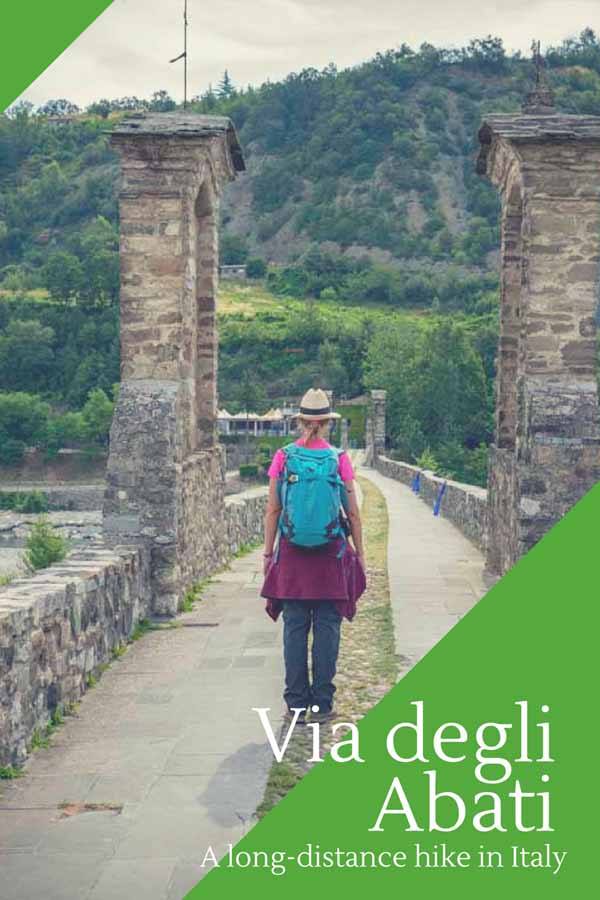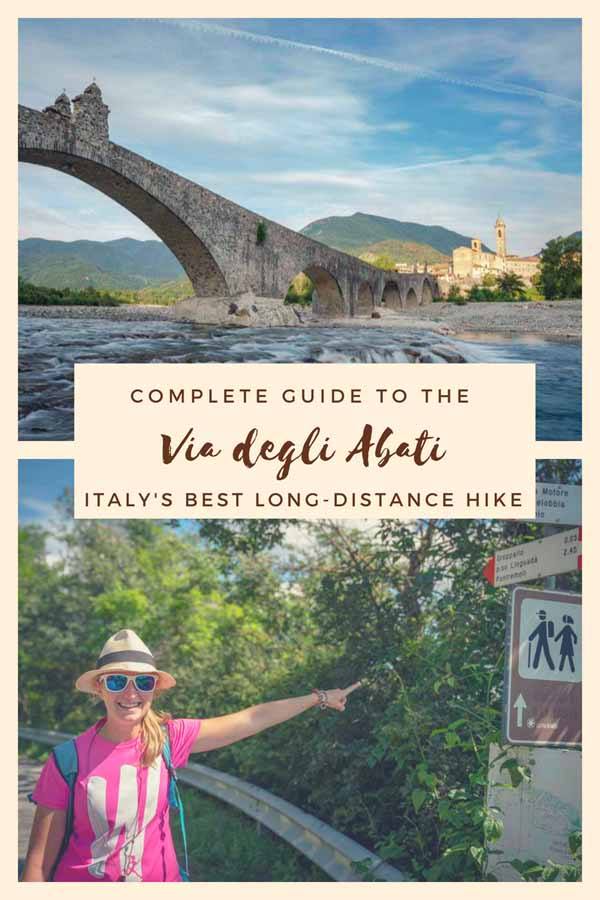Have you ever heard of the Via degli Abati? This 120 km trail across the Emilia Romagna Apennines is wild, full of history and walked only by a few hundred brave souls every year. If you’re looking for a long-distance hike across a beautiful part of Italy and away from the crowds, check out this complete Via degli Abati guide!
An excerpt of this article was published on the e-magazine Unforgettable Experiences #InEmiliaRomagna – you can download it here!
Via degli Abati may very well be the perfect Italian long-distance hike. It’s not too long – its best known section is only 120 km that can easily be hiked in 5 or 6 days, with excellent accommodation and food options throughout. The trail crosses the little-visited northwestern corner of the Emilia Romagna Apennines, from the town of Bobbio to Pontremoli just across the Tuscan border, passing through medieval churches and villages, remote mountain passes and forests where pilgrims have walked for millennia, on their way to Rome.
In fact, the Via degli Abati doesn’t start in Bobbio, but in Pavia, a further 70 km to the north, and in Pontremoli it connects with the more famous Via Francigena, the popular pilgrimage route from Canterbury to Rome. The Pavia-Bobbio route can be hiked over three days, and it was mapped and marked just recently – for this reason, we decided to stick to the more established Bobbio-Pontremoli route.
In June 2018 we hiked 90 km of the Via degli Abati, from Bobbio to Borgotaro. We’re planning to hike the last stage sometime this summer/autumn, and when we do we will certainly update our post. Meanwhile, check out our Via degli Abati guide, with practical info and a day-by-day trail description. And trust us – it will truly be an adventure to remember, a transformative experience in more than one way.
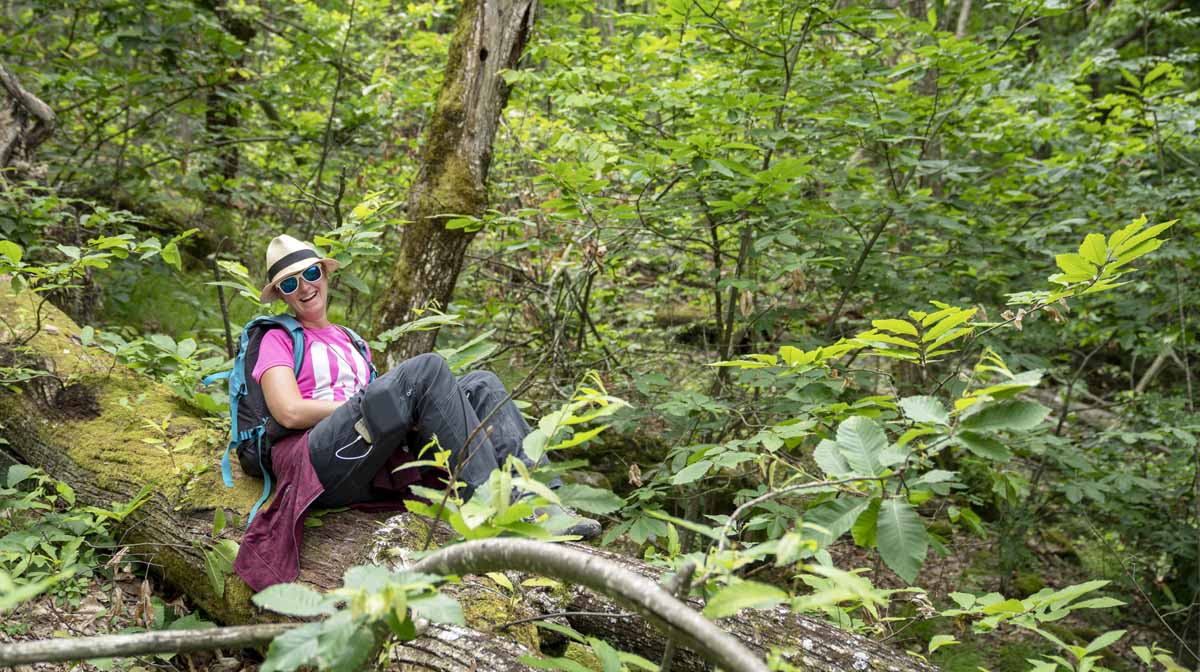
Click below to jump to the relevant section!
When to Hike the Via degli Abati
Via degli Abati History
The Via degli Abati is a variant of the Via Francigena, the famous pilgrimage trail from Canterbury to Rome, also crossing Emilia-Romagna. The ‘classical’ Via Francigena that we know today was the one described by Sigeric the Serious, the Archbishop of Canterbury that journeyed to Rome in 990 AD, to receive his investiture by the Pope.
Sigeric’s route mainly followed the plains of the Po Valley, largely bypassing the more treacherous Apennines. However, there was another shorter and more direct route, crossing the mountains and dating back to the 7th century – making it three centuries older than Sigeric’s Francigena.

This is what we know today as the Via degli Abati. The route was used by pilgrims, abbots, friars and Lombard kings travelling to Rome to pay homage to the Pope. One of the stops along the journey was St. Columban’s Abbey in Bobbio and the place of his death, a grotto in the mountains a few kilometres from Bobbio itself. These two sights made the Via degli Abati a popular route for pilgrims from the British Isles and devotees of the Irish saint.
The Via degli Abati was then ‘rediscovered’ in the 1990s by a local historian, and the trail is now maintained by groups of local volunteers. Only about 800 people hike the Via degli Abati every year, and that includes the 300 people taking part in the Abbot’s Way, an ultra trail race taking place every year along the trail. To put things into perspective, the Camino de Santiago is hiked by 250,000 people yearly. Make sure you go there before it becomes the new Camino!
Would you like to know about another amazing long-distance hike in Emilia-Romagna? Check our guide to hiking and cycling Dante’s Way!
When to Hike the Via degli Abati
The Via degli Abati can easily be hiked from April to October. The maximum altitude reached is just over 1200 meters – snow, rain and poor visibility are a likely occurrence in Winter, and since crowds are not really an issue along the Via degli Abati, you may as well stick to Spring, Summer and early Autumn.
The Abbots Way ultra trail takes place in late April/early May. The trail is still open during the race, but we would recommend to plan alternative dates in order to avoid getting in the way. During Summer time the heat can get unbearable, so plan to start very early if the forecast exceeds 30° in the middle of the day.
We hiked from June 24th to 27th and we were lucky to have excellent weather conditions – the days were dry and sunny and the temperature never exceeded 25°.
What to Pack
There’s accommodation all through the Via degli Abati, so camping equipment is not really necessary. For a detailed description of what goes into our bags on long-distance hikes, please refer to our long-distance hike packing list.
We used our excellent Osprey hiking backpacks as usual, but instead of our usual trail shoes we used hiking boots as the altitude difference covered each day was considerable and we wanted extra ankle support.
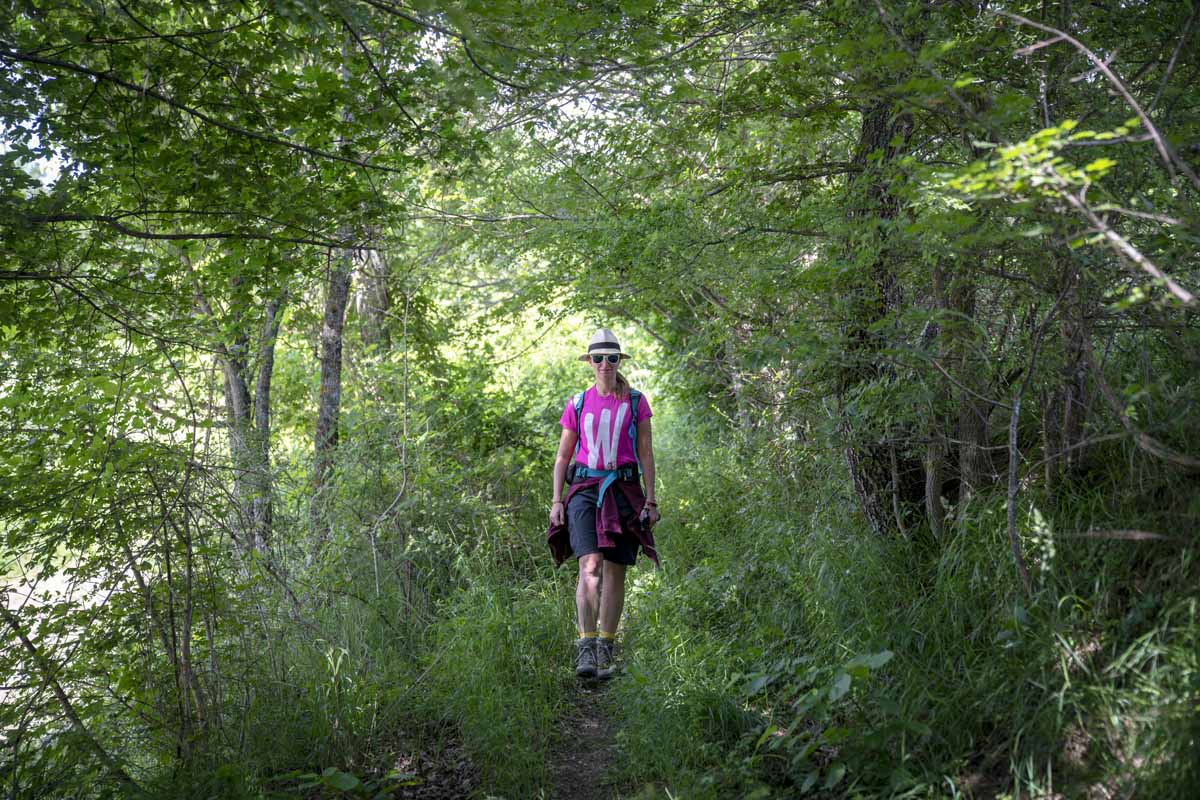
Fitness
The Via degli Abati is considerably harder than other long-distance trails we’ve covered in the past, like GardaTrek or the GR1. Total duration is 120 km and the total uphill altitude difference covered is 5500 meters over 5 days – which means an average of 1000 meters each day.
There aren’t many steep climbs, but there is a lot of steady walking uphill – if this is not something you’re used to, make sure you practice before hiking the Via degli Abati. We also recommend training to hike with a backpack on to make sure you’re using the right type of backpack and not packing more than you can carry.
Via degli Abati Orientation
The Via degli Abati is well marked throughout, with red and white markers painted on trees, rocks and on the back of street signs. Besides the trademark red and white stripes, you may also find a stylised VA marking the path. Red and white signs with distances to major points of interest are placed along major intersections and all variants are clearly signposted.
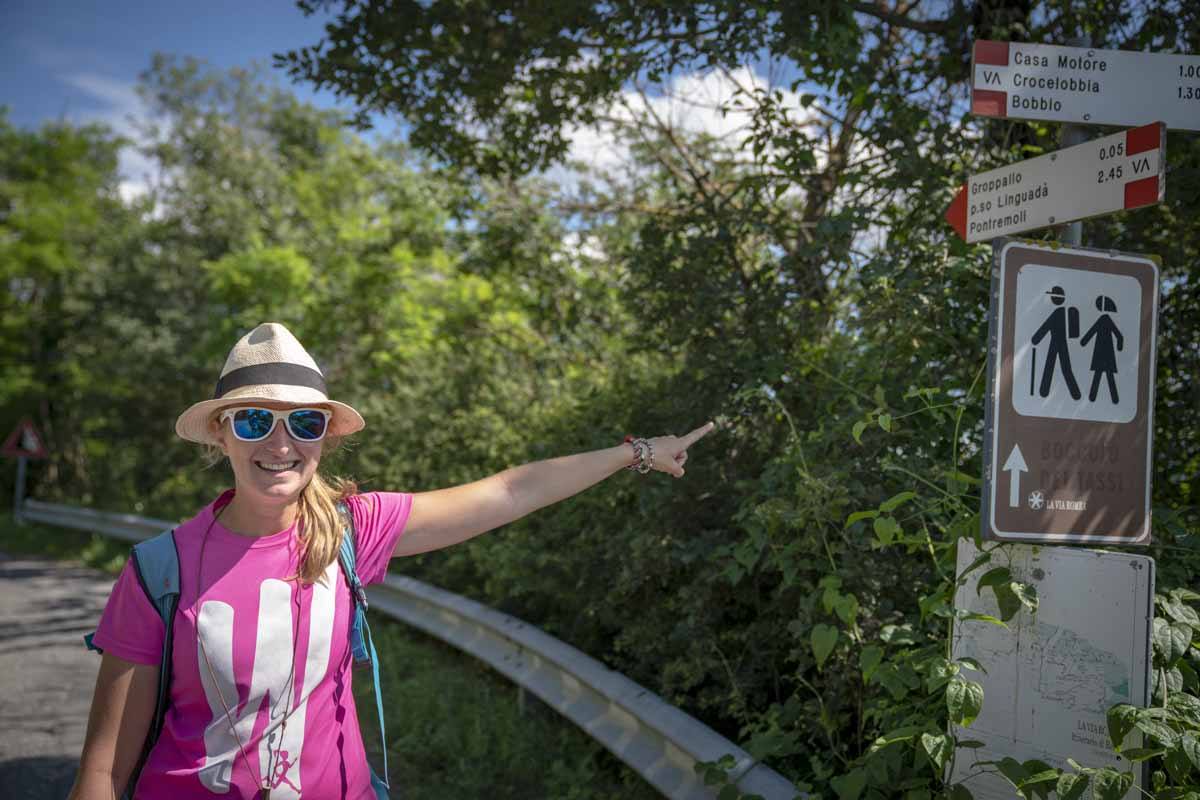
We have had no major trouble following the trail. We didn’t use a GPS this time, but if you prefer to do so, you can download the GPX trail here. If you don’t have a GPS, you can download the ViewRanger app on your smartphone and follow the trail directly on your phone – you can download the ViewRanger trail at the link above.
In any case, make sure you also get the official Via degli Abati paper map – you can order it online on the official Via degli Abati website, or pick it up in Bobbio at the tourist office and at the ‘Il Papiro Profumato’ bookstore. You can also get a free ‘pilgrim’s passport’ from both locations, where you can collect stamps in places along the trail.
Dangers & Annoyances
While you hike the Via degli Abati you may not encounter another person along the trail, and mobile reception is spotty at best. For this reason, we do not recommend the Via degli Abati to solo hikers – if you fell and hurt yourself, or if something happened, it may be hard for you to seek help. It’s much better to go in pairs or small groups. If you’re a die hard solo traveller, leave word to your chosen accommodation to send help if you do not turn up at the end of the day.
You may also come across wild animals along the Via degli Abati – we saw deer and snakes, but thankfully no vipers. There are also wild boars in the area, and they may be aggressive, but we didn’t see any.
Another animal you should really be careful of is ticks – we were bitten several times during the last stage to Borgotaro. If you are bitten, make sure you remove all ticks properly, monitor the bite location for rashes, and seek immediate treatment if a bull’s eye rash pops up. Lyme disease is extremely rare in Italy, but it is now unknown.
Accommodation
There are hotels, farmhouses and B&B at the end of each stage. In Nicelli and Groppallo there are only very few rooms available, so we recommend booking ahead and reconfirming your arrival time on the day as you get close to destination. We have included accommodation details in the relevant day-to-day sections.
It is also possible to camp along the Via degli Abati. There are no organised campsites, but some B&B may let you pitch your tent in the garden if you ask in advance and pay a small fee. Otherwise, just choose a secluded spot along the trail, and don’t forget to be responsible with your environmental footprint.
Food & Water
In the towns and villages at the beginning and end of all stages you’ll find bars and restaurants, or you can always ask your accommodation if they also offer meals. We always had breakfast and dinner in our hotel/B&B to make things easier, and always had really good meals.
During the day you’ll be hiking through small villages, but there aren’t many lunch options along the trail, so we found it easier to ask our accommodation if they could provide a packed lunch for a small extra charge.
However, most of these small towns and villages have a water fountain with free, fresh drinkable water. The official Via degli Abati paper map indicates all water sources with a blue drop – we found it extremely useful to prevent running out of water or carrying too much.
Via degli Abati Trail Guide
Day 1 – Bobbio to Nicelli
Distance: 22 km (6 hours walk) Ascent: 1300 m
Where we stayed: Albergo Ristorante Piacentino (Bobbio), B&B Le Margherite (Nicelli)
The Via degli Abati starts in Bobbio, a town located on the banks of the River Trebbia about 40 minutes drive from Piacenza. Bobbio’s history is strongly related to the abbey founded in the 7th century AD by the Irish monk Saint Columban. The abbey survived as a monastery until the 19th century, and in the Middle Ages it was known for its scriptorium, where thousands of codices and manuscripts were copied through the centuries.
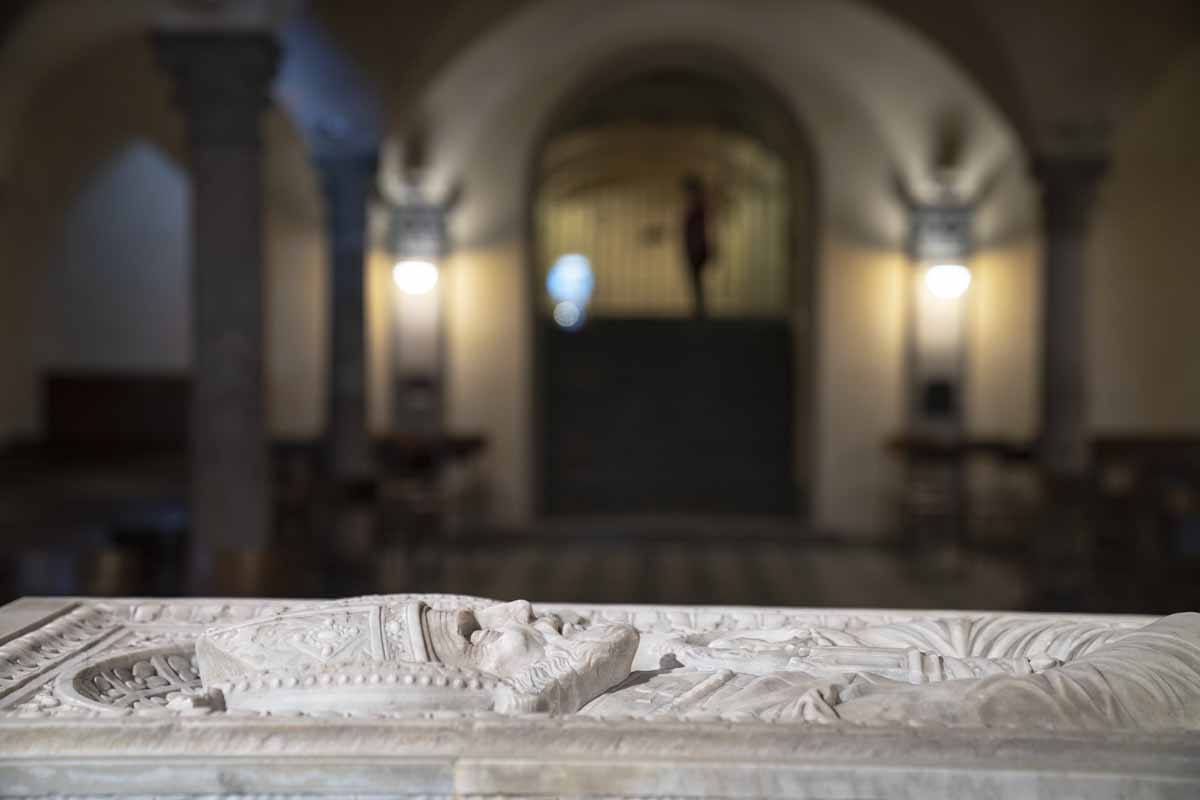
It’s worth spending at least half a day in Bobbio, checking out the main sights including the Abbey, the Cathedral and Castle overlooking town, before enjoying a good night’s sleep and heading off on the Via degli Abati.
The Via degli Abati starts by crossing the ‘Ponte Gobbo’ out of town, a stunning medieval bridge and one of many ‘Devil’s Bridges’ found across Italy. Follow the trail heading up towards Coli. The first part is really steep, with the trail weaving in and out of the woods, passing the villages of Santa Cecilia and Fontana, before reaching Coli after 2 hours and 500 meters positive altitude difference. There are really nice views of Bobbio from above as walk uphill, when the trees open up.
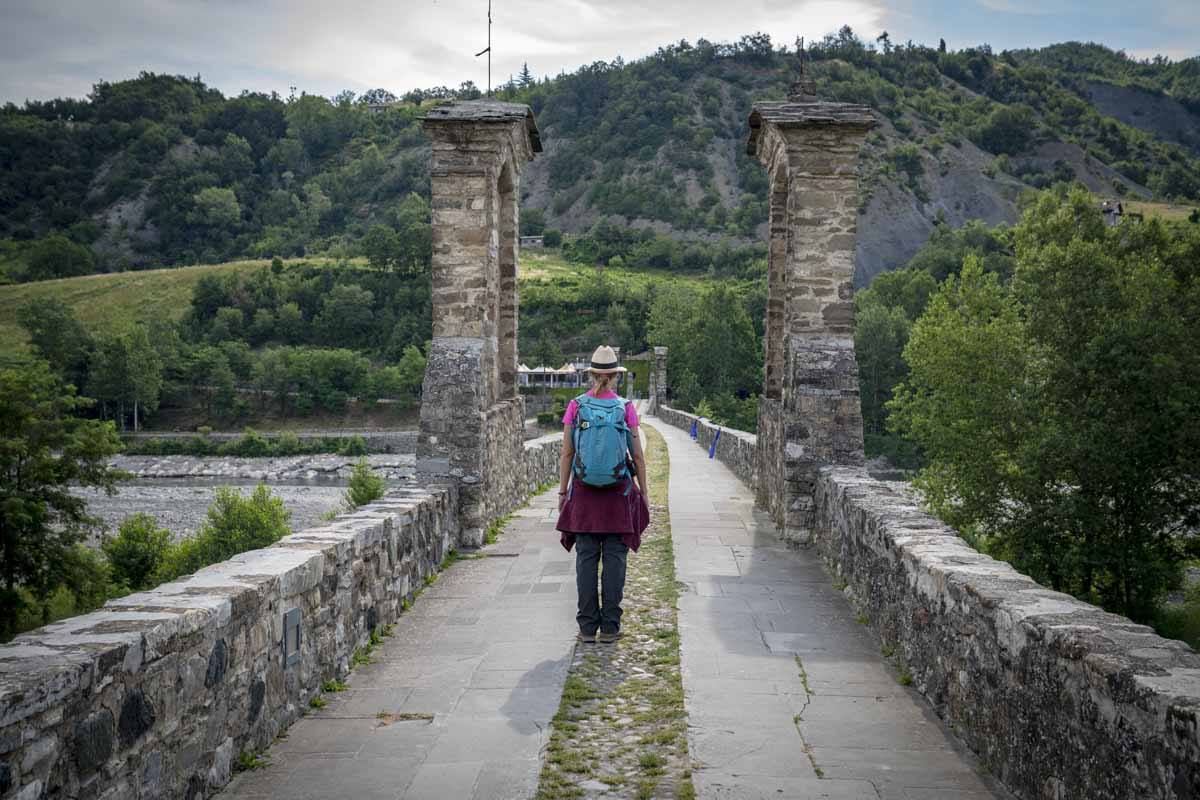
After Fontana, you reach the top of the first hill and you’ll see Coli just below. The Via degli Abati continues downhill, through the village and then across a stream. Shortly after the stream, make sure you follow the new Magrini-Faraneto variant, clearly signposted on a wall. This allows you to skip a steep forest section where a number of trees were killed by glaze last winter and now obstruct the path.
Not far from Coli it’s also possible to visit the Eremo di San Michele, the grotto where Saint Columban died. However, we didn’t go there because the variant would add too many extra kilometres, and because the trail is in poor condition following glaze damage and a landslide. I will update the post after receiving confirmation that the trail has been fixed.
Following the Magrini-Faraneto variant, you’ll reach Faraneto Castle, where you can stop for a while to check out its interesting architecture. Then keep going – the trail will keep climbing and will cross the hamlets of Agnelli, Cornaro, and Pescina, until you reach the Sella dei Generali, the highest point along the Via degli Abati at 1238 meters above sea level.
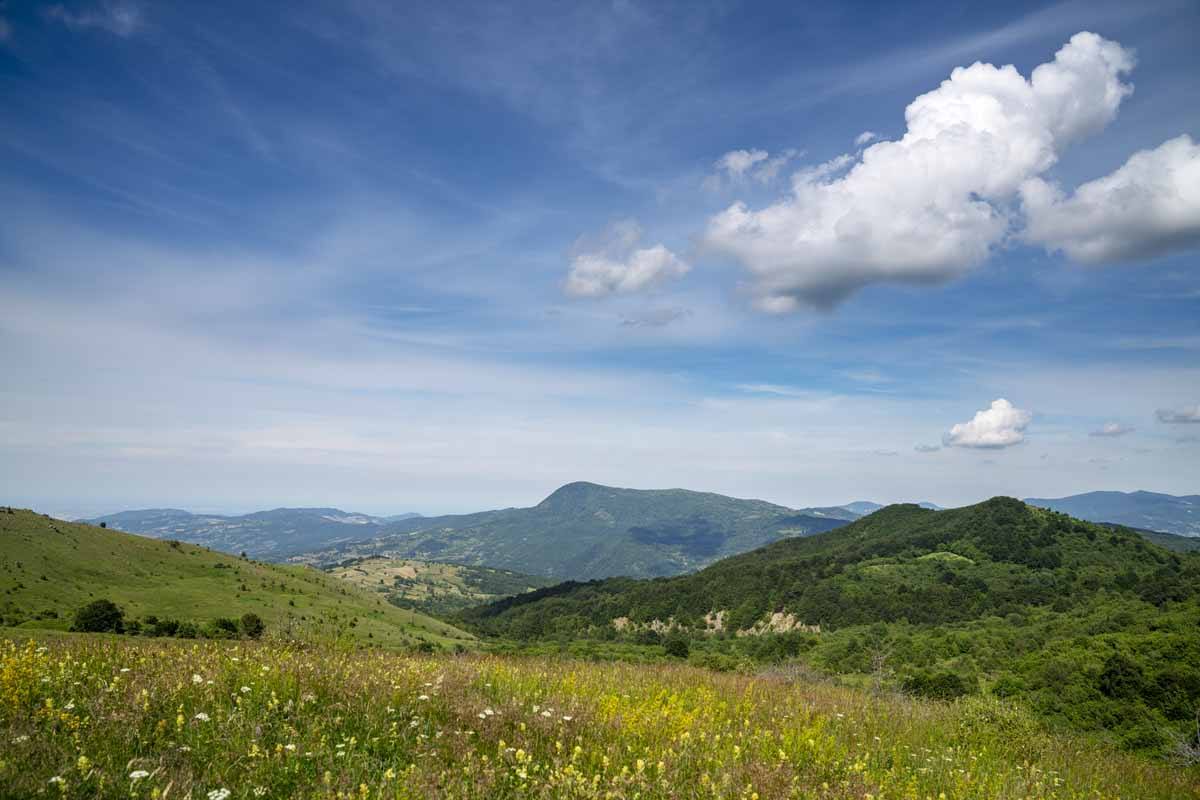
As you climb towards the Sella, the scenery is truly spectacular – you’ll be above the treeline at that stage, with mountains all around you. The Via degli Abati continues following the mountain ridge after the Sella, and then heads down to Nicelli via Fontanone, where you can fill your water bottle.
The first day is fairly long and exhausting, especially if you are not used to long-distance hiking. You can choose to break the stage up in Coli, where you can stay at the local hostel – I couldn’t find a website, but you can call +39 0523 931066 / 931117 for info on prices and availability.
Day 2 – Nicelli to Groppallo
Distance: 16 km (4 hours walk) Ascent: 600 m
Where we stayed: Albergo Ristorante Salini (Groppallo)
If you’re hiking in summer, ask in Nicelli whether it’s possible to wade across the River Nure. This is the way we went and it is considerably shorter than the alternative, which goes across Farini, adding just over two kilometres to the total distance.
The trail starts by heading steadily downhill all the way to the River Nure, through farmland first, then woods. The trail is surrounded by greenery and vegetation, the path is mostly downhill and very pleasant. Pass the village of Bolderoni, the Molino de Mortè (an old mill) and the villages of Vigonzano and Guglieri before reaching Crocelobbia, another handful of houses close to a bridge, after which you’ll be making your way towards the River Nure.
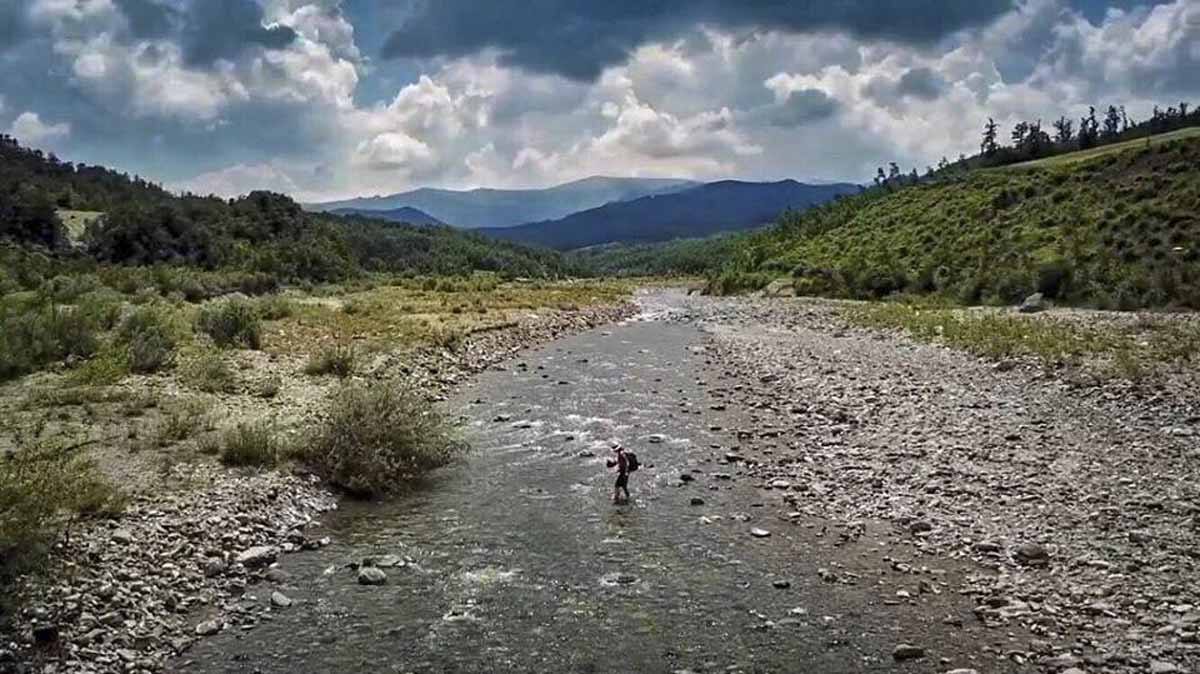
Then it’s time to wade across the Nure – there isn’t one designated ‘crossing point’. It’s very easy, just spend some time trying to find a good spot, with not too many loose rocks, no strong currents and a bank on the opposite side that is not too steep. After crossing, walk across the woods until you find a paved road – follow it for a little while until you find a path on the left hand side, heading towards Chiarabini.
In Chiarabini, we noticed a discrepancy between the gpx trail and the trail markings. The gpx follows the provincial road passing just south of Chiarabini, leading you to Frè, Groppazzolo and then Groppallo in just 5 km. If you’re tired, or it’s raining, by all means go this way – it’s an easy way to get to destination a little quicker.
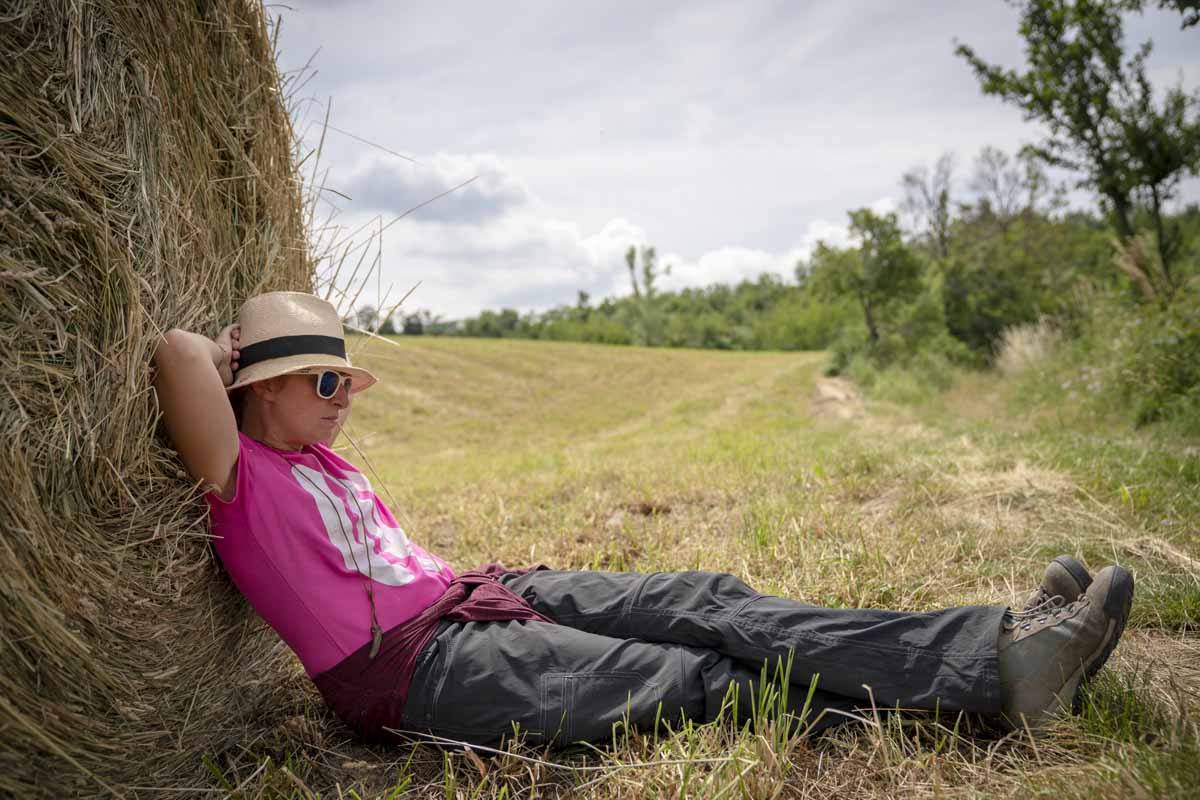
However, the ‘real’ Via degli Abati follows a forest road going through a wooded area just out of Chiarabini, climbing steadily through forests and a few sparse houses. The path then meets the paved road briefly just after Frè, then cuts inland again through the forest and climbs steeply to reach Groppazzolo and then Groppallo, a sleepy village developed around the main road, about 300 meters from beginning to end.
This is the easiest day of the whole hike, a very pleasant walk with no technical difficulties and no challenging sections besides the Nure crossing, which may not appeal to some people.
Day 3 – Groppallo to Bardi
Distance: 22 km (5 hours walk) Ascent: 600 m
Where we stayed: Agriturismo Ca’ d’Alfieri (5 km outside Bardi)
The third stage starts by crossing Groppallo, heading towards Bardi. Once again, if the weather is not nice it’s possible to walk alongside the provincial road all the way to Passo Linguadà, the mountain pass separating the Parma and Piacenza provinces.
However, the ‘real’ Via degli Abati reaches Linguadà through a succession of paths, mule tracks and forest roads weaving in and out of the forest, passing hamlets like Selva Sopra and Selva Sotto, after which you’ll encounter a stunning medieval stone tower, and Bruzzi where you can stop at the Bar Monte Lama for lunch or a snack.

After Bruzzi, a steady half hour climb will take you to Passo Linguadà, with a beautiful view over the Apennines and farmland below. About 5 minutes before reaching the pass you’ll find a deviation pointing to the Variante Alta Monte Lama – a higher variant of the path climbing to the plateau at the top of Mount Lama. This mountain is the largest plaque of jasper in the Emilia Romagna apennines, where Paleolitic tools were found, dominating the valley with its 1340 meter summit.
The Monte Lama variant adds about an hour to an hour and a half to the duration of the stage, and we decided not to take it. Instead, from Passo Linguadà we continued downhill towards Boccolo dei Tassi, a town that welcomed pilgrims on the Via degli Abati ever since the Middle Ages. Nowadays, a large stone fountain and some very friendly people are what remains of Boccolo dei Tassi’s hospitality tradition – to rest, you’ll have to make your way to Bardi.
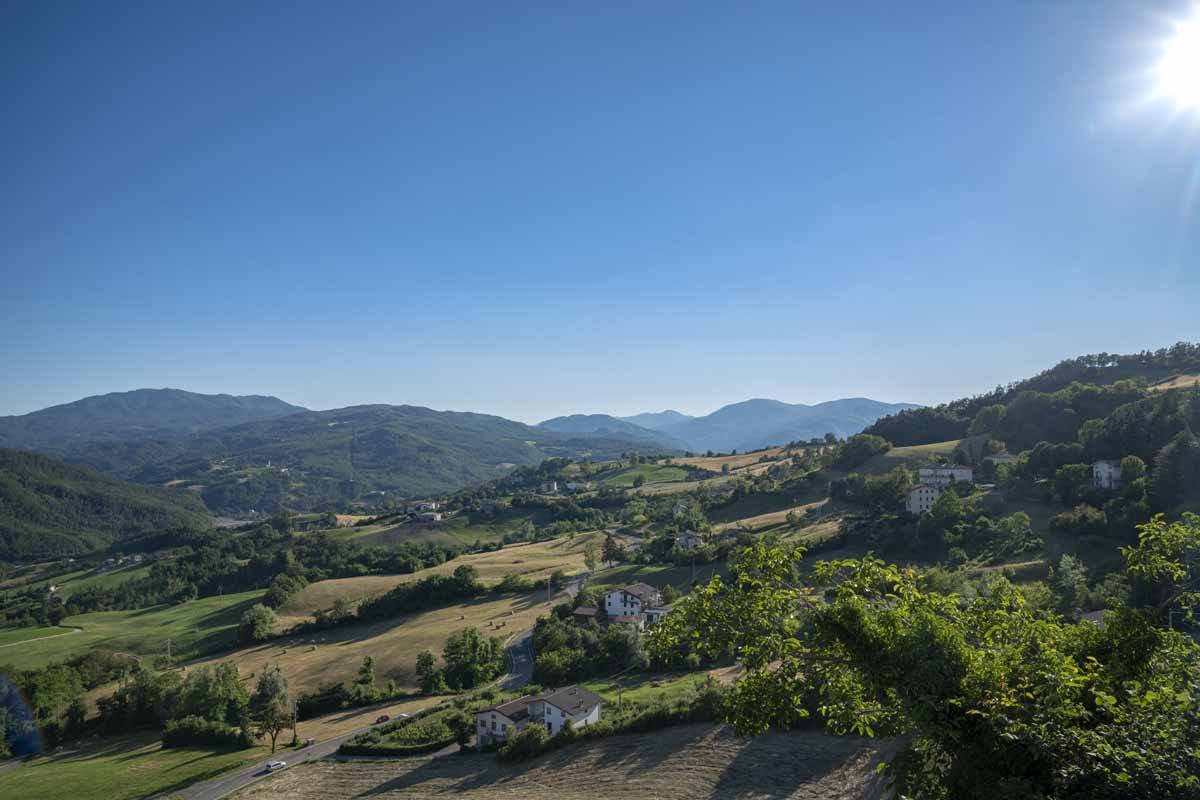
Continue downhill crossing a small stream (nothing like the Nure, don’t worry!). The path weaves around the provincial road, travelling through hay fields and forests, crossing the villages of Cerreto and Grezzo. From Grezzo, it’s just a small push towards Bardi. Unfortunately, the last 5 km follow the provincial road.
After a little while, Bardi becomes visible at the bottom of the hill, with its medieval town centre and imposing castle surrounded by the mountains. At the entrance of Bardi stands the small San Siro Chapel, where pilgrims were able to seek shelter in the Middle Ages.
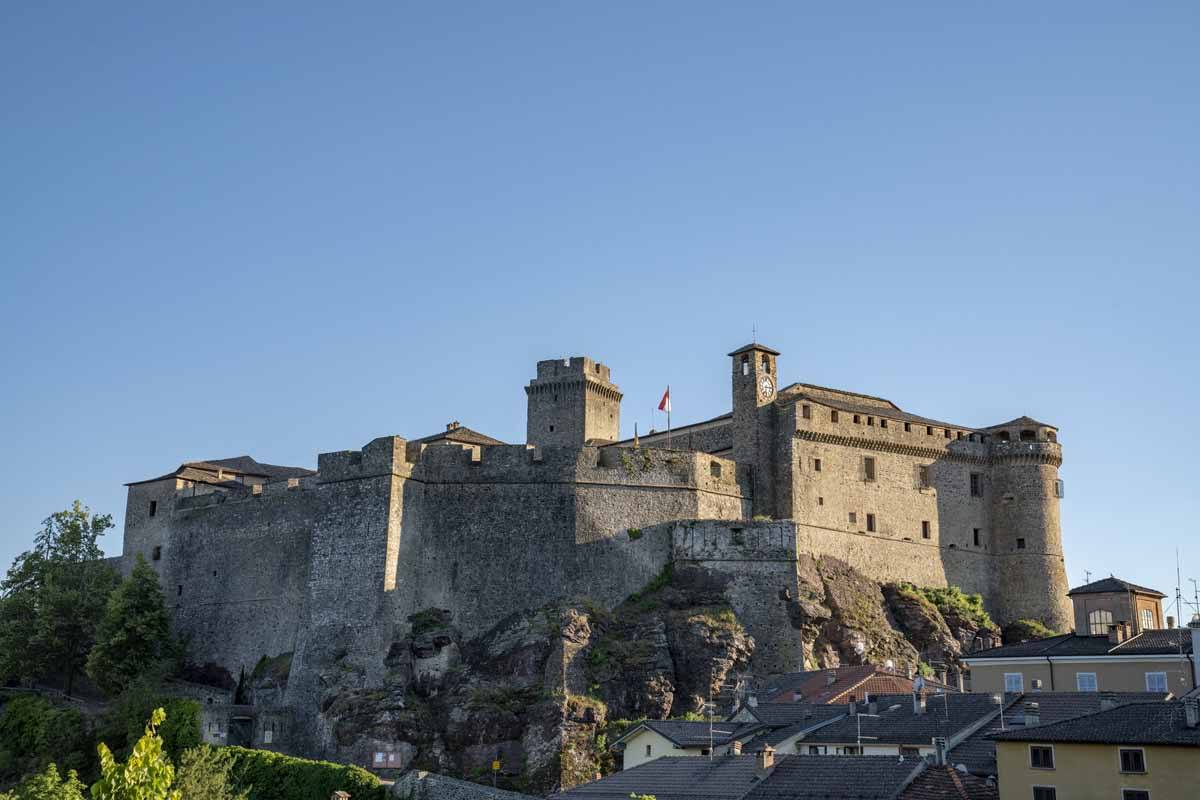
If you make it to Bardi before 4 pm, you can join the guided tour to the Castle. Alternatively, just do what we did and walk around it, admiring it from outside and looking at the beautiful red jasper rock atop which the castle was built.
Day 4 – Bardi to Borgo Val di Taro (Borgotaro)
Distance: 30 km (7.30 hours walk) Ascent: 1000 m
Where we stayed: Agriturismo Ca’ d’Alfieri (5 km outside Bardi)
We spent the night at Ca d’Alfieri, an agriturismo offering meals and accommodation in a 19th century farmhouse. Ca d’Alfieri is just outside Bardi, so by staying there we skipped the first 5 km of the 33 separating Bardi from Borgotaro, the destination of the fourth day along the Via degli Abati.
Those staying in Bardi will start the day by following the old municipal road heading downhill to the bridge crossing the Ceno stream, and then make their way up the steep path climbing over the right bank of the Noveglia stream to Chiappa, and then follow the trail to Monastero, climbing gently and weaving in and out of the woods.
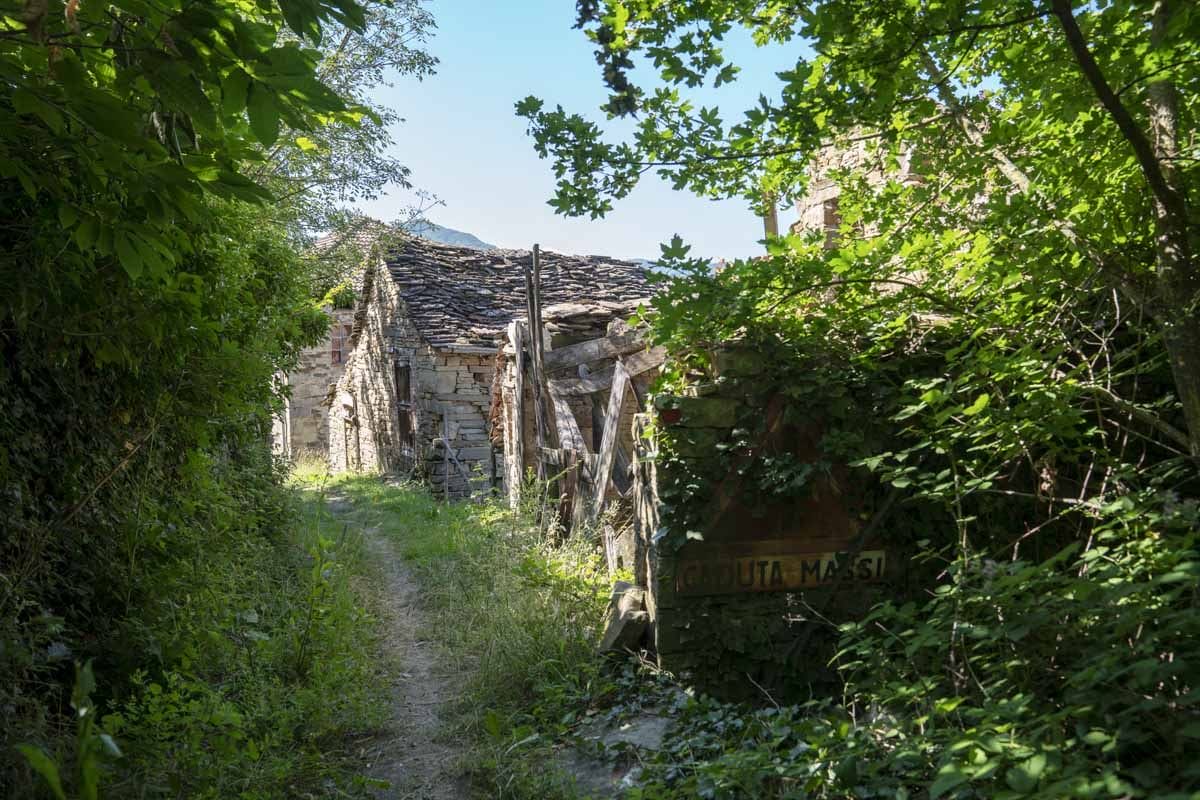
If you’re staying at Ca d’Alfieri, ask Maurizio to show you the path across his land to the Via degli Abati – keep your eyes peeled for the stunning stone washbasin, located about 300 meters from the farmhouse, in use until the mid-1960s.
After Monastero, the path continues with a series of moderately steep ups and downs again, crossing the villages of Noceto, Brè and Pieve di Gravago. Near Gravago you’ll be see a 17th century washhouse and a centenary tree, under which pilgrims of yesteryear sought shelter and enjoyed the shade. The path follows heading south, passing a couple small villages, heading to Osacca, another village with a long-running hospitality tradition where it’s also possible to stay the night.
Before Osacca you’ll see a fork in the path with two variants – a high one, climbing steeply through some beech woods, and a lower one that also happens to be a kilometre shorter. The lower variant was recently opened – we recommend opting for that over the high path, as it’s a long and gruelling hike all the way to Borgotaro, and the high path doesn’t include any points of interest that make it worth the extra effort.
Osacca was also the location of one of the first battles of the Italian Resistance during WW2 – there’s a sign remembering this battle that took place on Christmas Night in 1943. After leaving Osacca behind the path enters the woods again, and it starts climbing steadily to the mountain ridges, before starting the long descent towards Borgotaro.

In the place known as La Ramata the path divides again, with two options – a two hour one, and a four hour one. If you’re tired, by all means opt for the two hour variant – however, we were told it’s far less scenic and includes longer sections on paved roads. The ‘classic’ Via degli Abati is the four hour version, following the ridge to La Maestà, a secluded chapel immersed in the woods. The chapel is immaculately kept, and can be used as a shelter in case of bad weather.
The path continues down to San Cristoforo via a series of turns and switchbacks. Some sections of the path are very overgrown – if the situation is the same when you hike, please check your body carefully for ticks, as we were bitten several times.
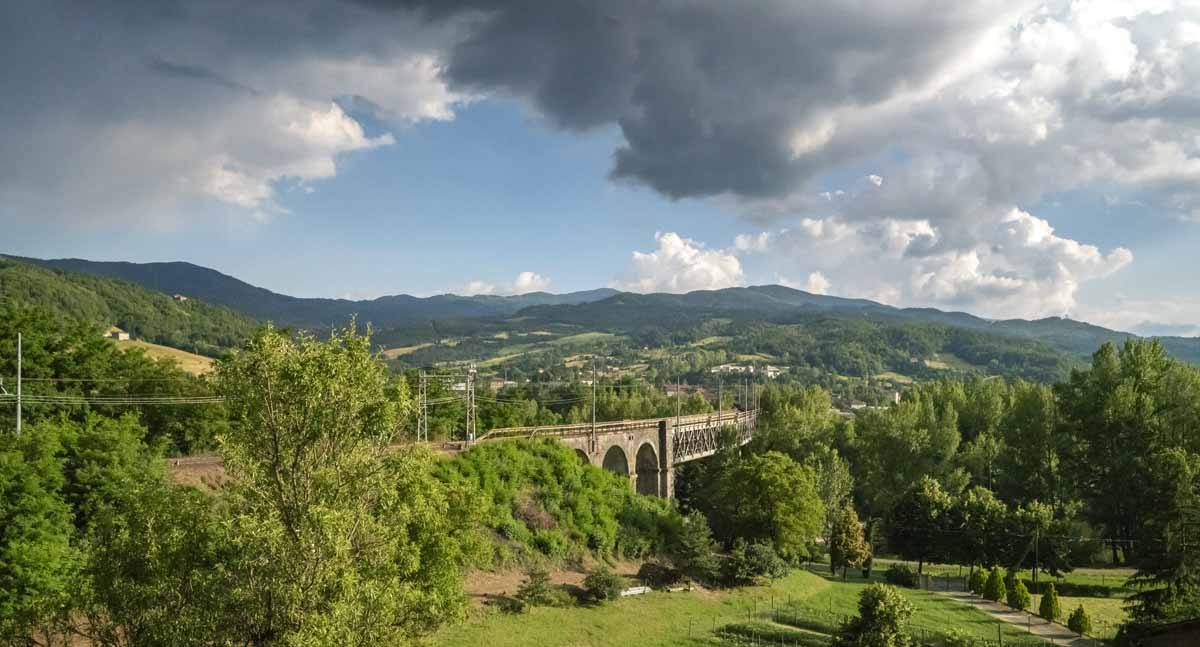
After San Cristoforo, it’s only about an hour or so to Borgotaro, famous for its delicious mushrooms and pretty historic centre. The trail follows a cycle path into town that also overlaps with the Via Crucis, always surrounded by trees and with no traffic in sight. That’s where our Via degli Abati ended – but we’ll be back shortly to hike the last leg over the mountains and the Tuscan border to Pontremoli!
Our trip was sponsored by Turismo Emilia Romagna as part of the Blogville project. We would like to thank all members of the Via degli Abati association for helping us along the way!
Pin it for later?
